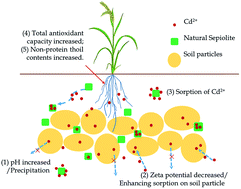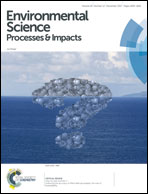Remediation mechanisms for Cd-contaminated soil using natural sepiolite at the field scale
Abstract
Remediation of heavy metal polluted agricultural soil is essential for human health and ecological safety and remediation mechanisms at the microscopic level are vital for their large-scale utilization. In this study, natural sepiolite was employed as an immobilization agent for in situ field-scale remediation of Cd-contaminated paddy soil and the remediation mechanisms were investigated in terms of soil chemistry and plant physiology. Natural sepiolite had a significant immobilization effect for bioavailable Cd contents in paddy soil, and consequently could lower the Cd concentrations of brown rice, husk, straw, and roots of rice plants by 54.7–73.7%, 44.0–62.5%, 26.5–67.2%, and 36.7–46.7%, respectively. Regarding soil chemistry, natural sepiolite increased the soil pH values and shifted the zeta potentials of soil particles to be more negative, enhancing the fixation or sorption of Cd on soil particles, and resulted in the reduction of HCl and DTPA extractable Cd concentrations in paddy soil. Natural sepiolite neither enhanced nor inhibited iron plaques on the rice root surface, but did change the chemical environments of Fe and S in rice root. Natural sepiolite improved the activities of antioxidant enzymes and enhanced the total antioxidant capacity to alleviate the stress of Cd. It also promotes the synthesis of GSH and NPT to complete the detoxification. In general, the remediation mechanisms of natural sepiolite for the Cd pollutant in paddy soil could be summarized as the collective effects of soil chemistry and plant physiology.



 Please wait while we load your content...
Please wait while we load your content...